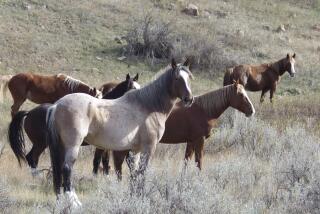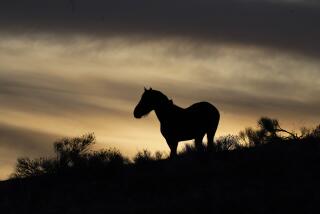Wild horses couldn’t drag her away
For the last seven years, Culver City-based artist Jennifer MaHarry has been photographing wild horses in the West.
“Their free spirit and majestic beauty is what initially captivated me,” said MaHarry, founder of Eden Creative, where she designs print ad campaigns for film. It was after visiting Wild Horses in Need, a rescue center in Ojai, that she learned of their at times inhumane treatment in captivity and decided to use her craft to shed light on their plight.
Photographed in the wilderness, at roundups, government holding facilities and horse rescue sanctuaries in Utah and California, several of her images can be seen at the G2 Gallery in Venice, with a full-scale show planned there in June.
FULL COVERAGE: 2013 Spring arts preview
Her breathtaking photos taken in the mountain ranges outside Salt Lake City capture the elegant creatures in their natural habitat. An intimate portrait of a bonding moment between mare and foal or a panoramic shot of a gallant steed poised against the snow-capped Onaqui Mountains masks their predicament.
In 1971, Congress passed the Wild Free-Roaming Horse and Burros Act to protect and control wild horses on public range lands, recognizing them as “living symbols of the historic and pioneer spirit of the West.” Since then, nearly 270,000 have been removed from public lands, including a recent roundup of mustangs in Nevada and Montana.
The livestock industry wants more grazing land for cattle and blames the horses for destroying the grass. There’s no official census, but there are 20,000 to 27,000 wild horses remaining in the U.S. by some estimates.
The potential opening of a New Mexico slaughterhouse (the first for horses in the U.S. in six years), mixed with a recent scandal in Europe over horse meat turning up in beef, has equine rights activists especially concerned. .
PHOTOS: Arts and culture in pictures by The Times
Last year, MaHarry managed to document the roundups (or gatherings) by the Bureau of Land Management.
“It felt like I was on a secret mission,” she recalled of meeting a BLM representative in the dark at a Flying J truck stop outside Tooele, Utah. “It was otherworldly. We were driving off-road for hours on bumpy terrain, passing military stations, uranium dumps and test bombing sights in this desolate, high desert wilderness.” She photographed the roundups every day for a week.
Helicopters are used to attract the horses while a “Judas horse” tricks the herds into following him through jute fencing traps that funnel the animals into cramped steel pens where they are then separated by age and gender. Mares are occasionally released back into the wild after receiving infertility inoculations, while others are put up for adoption. The rest are stockpiled in government facilities. Horses that fail to be adopted can be sold, with many being sent to slaughterhouses in Mexico and Canada and their meat exported to Europe.
“What is happening is such a horrible disservice to these majestic creatures,” said MaHarry. “They’ve created civilizations, they’ve gone to war, plowed fields, transported us and changed our conception of distance and time. Everything we asked from a horse, they’ve done.”
MORE
INTERACTIVE: Christopher Hawthorne’s On the Boulevards
Depictions of violence in theater and more
PHOTOS: Arts and culture in pictures
More to Read
The biggest entertainment stories
Get our big stories about Hollywood, film, television, music, arts, culture and more right in your inbox as soon as they publish.
You may occasionally receive promotional content from the Los Angeles Times.










